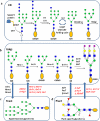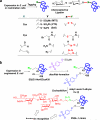Emerging technologies for making glycan-defined glycoproteins
- PMID: 22141574
- PMCID: PMC3262938
- DOI: 10.1021/cb200429n
Emerging technologies for making glycan-defined glycoproteins
Abstract
Protein glycosylation is a common and complex posttranslational modification of proteins, which expands functional diversity while boosting structural heterogeneity. Glycoproteins, the end products of such a modification, are typically produced as mixtures of glycoforms possessing the same polypeptide backbone but differing in the site of glycosylation and/or in the structures of pendant glycans, from which single glycoforms are difficult to isolate. The urgent need for glycan-defined glycoproteins in both detailed structure-function relationship studies and therapeutic applications has stimulated an extensive interest in developing various methods for manipulating protein glycosylation. This review highlights emerging technologies that hold great promise in making a variety of glycan-defined glycoproteins, with a particular emphasis in the following three areas: specific glycoengineering of host biosynthetic pathways, in vitro chemoenzymatic glycosylation remodeling, and chemoselective and site-specific glycosylation of proteins.
Figures





References
-
- Dwek RA. Glycobiology: Toward understanding the function of sugars. Chem. Rev. 1996;96:683–720. - PubMed
-
- Haltiwanger RS, Lowe JB. Role of glycosylation in development. Annu. Rev. Biochem. 2004;73:491–537. - PubMed
-
- Dube DH, Bertozzi CR. Glycans in cancer and inflammation--potential for therapeutics and diagnostics. Nat. Rev. Drug Discov. 2005;4:477–488. - PubMed
Publication types
MeSH terms
Substances
Grants and funding
LinkOut - more resources
Full Text Sources
Other Literature Sources

